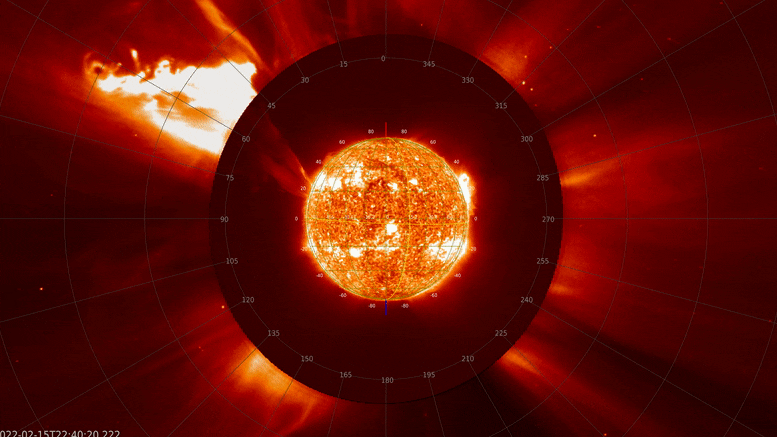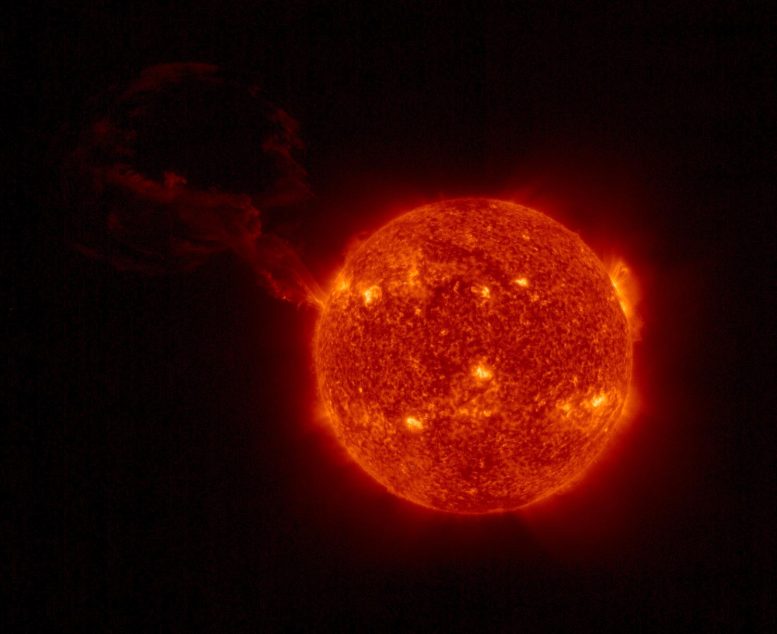
The ESA/NASA Solar Orbiter spacecraft has captured the largest solar prominence eruption ever observed in a single image together with the full solar disc.
Solar prominences are large structures of tangled magnetic field lines that keep dense concentrations of solar plasma suspended above the Sun’s surface, sometimes taking the form of arching loops. They are often associated with coronal mass ejections, which if directed towards Earth, can wreak havoc with our technology and everyday lives.
This latest event took place on February 15, 2022, and extended millions of kilometers into space. The coronal mass ejection was not directed at Earth. In fact, it is traveling away from us. There is no signature of the eruption on the solar disc facing the spacecraft – which is currently approaching the Earth-Sun line – meaning that it must have originated from the side of the Sun facing away from us.

The imagery was captured by the ‘Full Sun Imager’ (FSI) of the Extreme Ultraviolet Imager (EUI) on Solar Orbiter. FSI is designed to look at the full solar disc even during close passages of the Sun, such as during the upcoming perihelion passage next month. At closest approach on March 26, which will see the spacecraft pass within about 0.3 times the Sun-Earth distance, the Sun will fill a much larger portion of the telescope’s field of view. Right now, there is still a lot of ‘viewing margin’ around the disc, enabling stunning detail to be captured by FSI out to about 3.5 million kilometers, equivalent to five times the radius of the Sun.
Other space telescopes such as the ESA/NASA SOHO satellite frequently see solar activity like this, but either closer to the Sun, or further out by means of an occulter, which blocks out the glare of the Sun’s disc to enable detailed imagery of the corona itself. Thus, the prominence observed by Solar Orbiter is the largest ever event of its kind to be captured in a single field of view together with the solar disc, opening up new possibilities to see how events like these connect to the solar disc for the first time. At the same time, SOHO can provide complementary views to even larger distances.
Other space missions were also watching the event, including NASA’s Parker Solar Probe. Next week, Solar Orbiter and Parker Solar Probe will perform dedicated joint observations during Parker’s perihelion passage.
Even spacecraft not dedicated to solar science felt its blast – the ESA/JAXA BepiColombo mission, currently in the vicinity of Mercury’s orbit – detected a massive increase in the readings for electrons, protons, and heavy ions with its radiation monitor.
And while this event did not send a blast of deadly particles towards Earth, it is an important reminder of the unpredictable nature of the Sun and the importance of understanding and monitoring its behavior. Together with ESA’s future dedicated space weather mission Vigil, which will provide unique views of events like these, we can better protect our home planet from the Sun’s violent outbursts.
Never miss a breakthrough: Join the SciTechDaily newsletter.
11 Comments
When it rains (HZE ions, alpha particles, protons, electrons, neutrons, neutrinos or photons) it pours!
Is it possible to have a transparent, retractable solar flare shield stationed between the Sun and Earth to protect sensitive technology from these events?
I suspect the more our tech advances the more sensing/sensitive it will be and thus more easily affected by solar prominences.
Maybe it can absorb, block or repel incoming radiation.
These events may be showing is how the Sun/star is ‘feeling’ as it’s traveling through space orbiting the core. It can indicate a weather pattern or climate zone such as higher surrounding pressure thus causing the star to erupt. Perhaps space pressure isn’t the cause. Maybe it went through a high energy zone or maybe colder region causing it to contract. Whatever the external cause, it’s reaction indicates something.
I think the star adapts to its surrounding environment just as any creature, organism, planet or object does.
When Earth will travel through this region it may cause increased eruptions or quakes on earth to occur. The Sun may tell us what the Earth might do.
Our star/sun is our guiding star.
Those of us who were born in the decade of Sputnik will not live to see some very exciting decades in space exploration. But we can appreciate the hints at what is to come from today’s planned missions and their stated objectives.
Here’s hoping mankind overcomes it’s baser instincts, so it can realize the nature of it’s reality, finally. Good luck to us all. Kudos to our curiosity and ingenuity.
Built on the shoulders of our ancestors and with their hands. Thank you. And I’d encourage you to sit back and relax and to hang on as long as you can. There are exciting missions being planned and exciting results to be seen. A civilized world needs more people who have accepted humility and overcome their ego. Unfortunately, reality isn’t so simple or hospitable and I would say we ought to build on our base instincts as the foundation to our castles in the sky. Another idea is to channel our base urges and instincts into another area or field preferably intellectual stimulation with real world applications. But for this people need physical security and comfort. That’s when the blooming happens.
Maybe you can continue your work by doing just what you hoped: helping humanity overcome its baser instincts; or channeling them to more useful areas, field, work or even people: social, antisocial, foreign or domestic energy conversion, storage and transfer.
As the saying goes, if you want something done your way, you have to do it yourself.
We often forget the other half of mankind (womankind) and in our relations there is often misunderstandings and charged emotions. We’ve yet to master these biological, chemical and physical reactions because it’s often not in man’s control. I’ve yet to understand this dynamic and live it in an orderly peaceful way; it takes some [self]trust and adaptability, it seems.
Carl Sagan – A Worthy Goal (Um Objetivo Digno)
https://youtu.be/YYbZ0Xe6EXc
Marin ✅ right on professor…..spoken as a knowledgeable individual. Outstanding explanation. 🌞🤓⭐ life depends on sun/star 🌟 ✨ 😎 for sure. Weather is a science, earth is homeplanet,safety is avoiding danger. Smile 😃 🙂 its the weekend 😄 😀 ☺ 😊 😁 😎
Thanks, I had to look some things up (HZE & alpha) but then the thought came to me that our star is just adapting to its environment too.🤖🌞👽
Earth is a female-like oriental planet. Moon orbits after Earth.
Follow the females who follow the sun.
Schnuffel – Ich hab’ Dich lieb
https://youtu.be/82nBlkPiBcc
Kosmos ist meistens kalter leerer raum; zu hause bleiben🫀☝️🌌